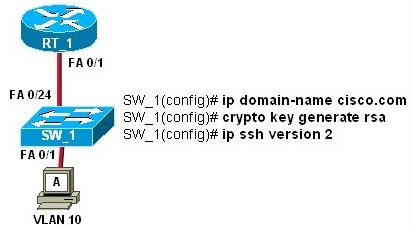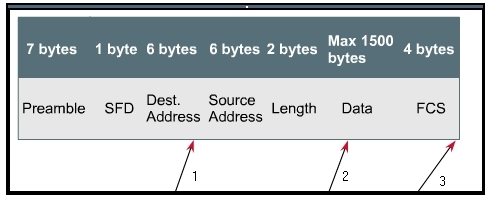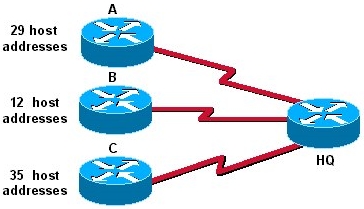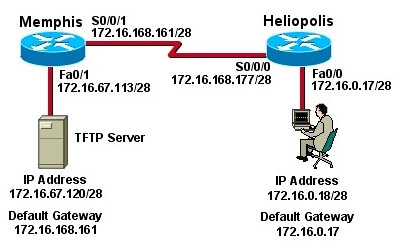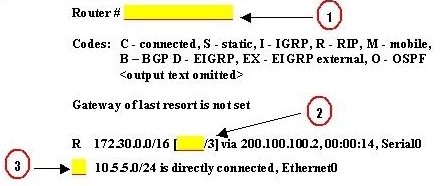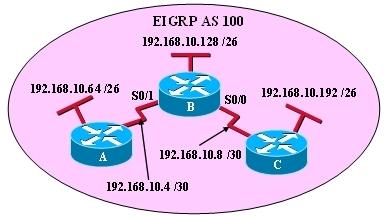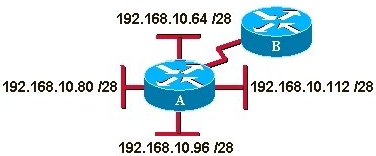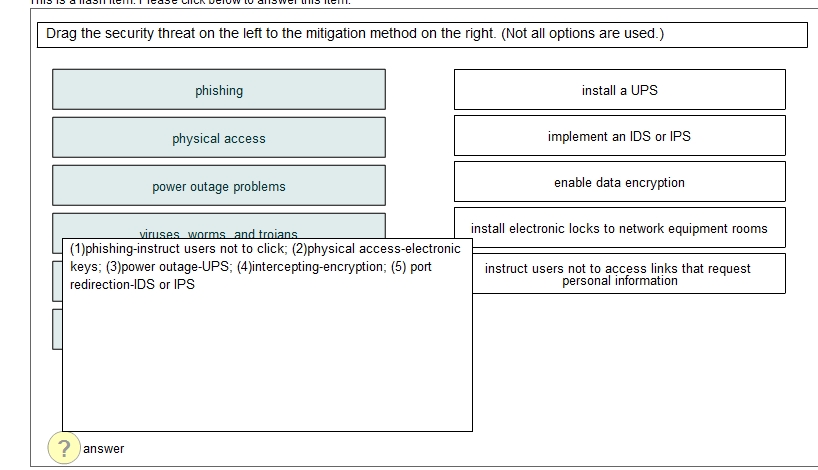CCNA Practice Certification Exam #2

Welcome back to another quiz where we’ll be taking another close look at a wide range of topics within the Cisco Certified Network Associate curriculum in order to gauge how far along you are in your studies to becoming a professional in any networking department you so choose. Good luck!
- 1.
Refer to the exhibit. The exhibit shows simplified protocol data units from different OSI model layers. Which three statements are true about the PDUs and the encapsulation process? (Choose three.)
- A.
PDU #1 is a frame.
- B.
PDU #2 is an application layer PDU
- C.
PDU #3 is a segment.
- D.
PDU #4 is a transport layer PDU.
- E.
The order in which these PDUs are created during the encapsulation process is 3, 4, 1, 2.
Correct Answer(s)
A. PDU #1 is a frame.
C. PDU #3 is a segment.
E. The order in which these PDUs are created during the encapsulation process is 3, 4, 1, 2.Explanation
The given correct answer states that PDU #1 is a frame, PDU #3 is a segment, and the order in which these PDUs are created during the encapsulation process is 3, 4, 1, 2. This means that PDU #1 is created after PDU #3 and PDU #4, and PDU #2 is created last. This is consistent with the encapsulation process in the OSI model, where data is first segmented at the transport layer (PDU #3), then encapsulated into a packet at the network layer (PDU #4), followed by encapsulation into a frame at the data link layer (PDU #1). Finally, at the application layer, the data is encapsulated into a message (PDU #2).Rate this question:
-
- 2.
Which three application layer protocols use TCP? (Choose three.)
- A.
SMTP
- B.
FTP
- C.
SNMP
- D.
HTTP
- E.
TFTP
Correct Answer(s)
A. SMTP
B. FTP
D. HTTPExplanation
SMTP, FTP, and HTTP are the three application layer protocols that use TCP. SMTP (Simple Mail Transfer Protocol) is used for sending and receiving email messages. FTP (File Transfer Protocol) is used for transferring files between a client and a server. HTTP (Hypertext Transfer Protocol) is used for communication between web browsers and web servers, allowing the retrieval and display of web pages. These protocols rely on TCP (Transmission Control Protocol) to establish a reliable and connection-oriented communication channel between the client and the server.Rate this question:
-
- 3.
Which two application layer protocols use the UDP protocol? (Choose two.)
- A.
Telnet
- B.
SNMP
- C.
SMTP
- D.
SQL
- E.
TFTP
Correct Answer(s)
B. SNMP
E. TFTPExplanation
SNMP (Simple Network Management Protocol) and TFTP (Trivial File Transfer Protocol) are the two application layer protocols that use the UDP (User Datagram Protocol) protocol. SNMP is used for managing and monitoring network devices, while TFTP is used for simple file transfers. Unlike TCP, UDP is a connectionless protocol that does not provide guaranteed delivery or error checking, making it suitable for applications that prioritize speed over reliability. Telnet, SMTP, and SQL, on the other hand, use TCP for their transport layer protocol.Rate this question:
-
- 4.
What are two functions that occur at the Internet layer of the TCP/IP model? (Choose two.)
- A.
Establishment of logical connections between source and destination hosts
- B.
End-to-end flow control
- C.
Determination of best paths through the network
- D.
Definition of the procedures used to interface with the network hardware
- E.
Packet switching
Correct Answer(s)
C. Determination of best paths through the network
E. Packet switchingExplanation
The Internet layer of the TCP/IP model is responsible for determining the best paths through the network and implementing packet switching. Determining the best paths involves selecting the most efficient routes for data transmission, considering factors such as network congestion and latency. Packet switching involves breaking data into smaller packets and sending them individually across the network, allowing for more efficient and reliable transmission. These functions are crucial for ensuring that data is delivered effectively and efficiently across the internet.Rate this question:
-
- 5.
Refer to the exhibit. All ports on switch A are in the sales VLAN and all ports on switch B are in the accounting VLAN. How many broadcast domains and how many collision domains exist in the exhibited network? (Choose two.)
- A.
3 collision domains
- B.
2 broadcast domains
- C.
5 broadcast domains
- D.
9 collision domains
- E.
10 collision domains
Correct Answer(s)
A. 3 collision domains
B. 2 broadcast domainsExplanation
The collision domain defines the network segment where collisions can occur when two devices transmit data simultaneously. Each switch port represents a separate collision domain, totaling 9 across both switches. In contrast, the broadcast domain encompasses devices that receive broadcast traffic, with 2 domains in this scenario, corresponding to the VLANs on each switch.Rate this question:
-
- 6.
A high-end Catalyst switch that supports both ISL and 802.1Q is to be connected by a link that will carry all VLAN traffic to a Catalyst 2960 LAN switch. What two commands are required to configure an interface on the high-end Catalyst switch to carry traffic from all VLANs to the Catalyst 2960 switch? (Choose two.)
- A.
Switch(config-if)# vlan all
- B.
Switch(config-if)# switchport access vlan 30
- C.
Switch(config-if)# switchport access vlan all
- D.
Switch(config-if)# switchport mode trunk
- E.
Switch(config-if)# switchport trunk encapsulation dot1q
Correct Answer(s)
D. Switch(config-if)# switchport mode trunk
E. Switch(config-if)# switchport trunk encapsulation dot1qExplanation
The two commands required to configure an interface on the high-end Catalyst switch to carry traffic from all VLANs to the Catalyst 2960 switch are "Switch(config-if)# switchport mode trunk" and "Switch(config-if)# switchport trunk encapsulation dot1q". The "switchport mode trunk" command configures the interface to operate in trunk mode, allowing it to carry traffic from multiple VLANs. The "switchport trunk encapsulation dot1q" command specifies that the trunk should use the IEEE 802.1Q encapsulation method.Rate this question:
-
- 7.
Refer to the exhibit. Based on the exhibited configuration and output, what would be the result of this command: Sw1# telnet 192.168.1.10
- A.
All packets will be dropped.
- B.
The Telnet session will succeed.
- C.
An error message that says “Session terminated” will appear.
- D.
An error message that says “Password required, but none set” will appear.
Correct Answer
A. All packets will be dropped.Explanation
Based on the exhibited configuration and output, the result of the command "telnet 192.168.1.10" would be that all packets will be dropped. This can be inferred from the fact that the Telnet session is not successful and there is no error message indicating any specific issue with the session or password requirement. Therefore, it can be concluded that the packets are being dropped without any further explanation provided.Rate this question:
-
- 8.
Refer to the partial device configuration that is exhibited. For which network topology is the configuration appropriate? RtrA(config)# interface fastethernet 0/0 RtrA(config-if)# no shutdown RtrA(config-if)# interface fastethernet 0/0.18 RtrA(config-subif)# encapsulation dot1q 18 RtrA(config-subif)# ip address 10.1.18.1 255.255.255.0 RtrA(config-subif)# interface fastethernet 0/0.44 RtrA(config-subif)# encapsulation dot1q 44 RtrA(config-subif)# ip address 10.1.44.1 255.255.255.0 RtrA(config-subif)# interface fastethernet 0/0.22 RtrA(config-subif)# encapsulation dot1q 22 RtrA(config-subif)# ip address 10.1.22.1 255.255.255.0a: B:c:D:
- A.
Image A
- B.
Image B
- C.
Image C
- D.
Image D
Correct Answer
D. Image DExplanation
The given configuration is appropriate for a router that is connected to a network using a VLAN-based topology. The "encapsulation dot1q" commands indicate that the router is configured to support VLAN tagging, allowing it to communicate with devices on different VLANs. The IP addresses assigned to each subinterface correspond to different VLANs, indicating that the router is able to route traffic between these VLANs. Therefore, the configuration is suitable for a network topology that utilizes VLANs for segmentation and routing.Rate this question:
-
- 9.
Refer to the exhibit and the following error message from the SwA switch. 00:22:43: %SPANTREE-7-RECV_1Q_NON_TRUNK: Received 802.1Q BPDU on non trunk FastEthernet0/1 VLAN1.00:22:43: %SPANTREE-7-BLOCK_PORT_TYPE: Blocking FastEthernet0/1 on VLAN0001. Inconsistent port type. Considering that the link between the two switches is good and the correct type, what could cause this error message?
- A.
The Spanning Tree Protocol has been disabled on one switch.
- B.
The Spanning Tree Protocol has been disabled on both switches.
- C.
The IEEE 802.1Q trunking port has a speed mismatch on one of the switches.
- D.
The SwA port is configured as a trunk port and the SwB port is configured as an access port.
- E.
The SwA port has IEEE 802.1Q trunking enabled and the SwB port has ISL trunking enabled.
Correct Answer
D. The SwA port is configured as a trunk port and the SwB port is configured as an access port.Explanation
The error message indicates that there is an inconsistency in the port type between the two switches. This suggests that one switch is configured as a trunk port (SwA) while the other switch is configured as an access port (SwB). This mismatch in port configuration can cause the Spanning Tree Protocol to block the port (FastEthernet0/1) on VLAN1, resulting in the error message.Rate this question:
-
- 10.
A network administrator is configuring a switch when an error message appears. The configuration commands and error message appear as follows: Switch(config)# interface fastethernet 0/1 Switch(config-if)# switchport mode trunk Command rejected: An interface whose trunk encapsulation is "Auto" can not be configured to "trunk" mode. What is the problem?
- A.
The switch port is configured as an access mode port.
- B.
The switch port does not support trunking on this port.
- C.
The encapsulation type must be changed to a compatible protocol before the port can be placed in trunk mode.
- D.
The no switchport trunk encapsulation auto command needs to be applied to the switch port before trunking can be enabled.
Correct Answer
C. The encapsulation type must be changed to a compatible protocol before the port can be placed in trunk mode.Explanation
The error message indicates that the switch port's trunk encapsulation is set to "Auto," which is incompatible with the "trunk" mode. To resolve this issue, the encapsulation type needs to be changed to a compatible protocol before the port can be configured as a trunk port.Rate this question:
-
- 11.
Of the protocols that are listed, which one needs to be functioning on a link in order for VTP to operate?
- A.
802.1Q
- B.
CDP
- C.
RIP
- D.
RSTP
Correct Answer
A. 802.1QExplanation
VTP (VLAN Trunking Protocol) is a Cisco proprietary protocol that allows for the synchronization of VLAN information across switches. In order for VTP to operate, the 802.1Q protocol needs to be functioning on the link. 802.1Q is the standard for VLAN tagging and allows for the encapsulation of VLAN information within Ethernet frames. CDP (Cisco Discovery Protocol) is used for network discovery and device identification, RIP (Routing Information Protocol) is a routing protocol, and RSTP (Rapid Spanning Tree Protocol) is a spanning tree protocol. None of these protocols are specifically required for VTP to operate.Rate this question:
-
- 12.
Refer to the exhibit. RT_1 is configured correctly with IP addresses and passwords but none of the computers can ping or telnet to RT_1. Which series of commands would correct the problem?
- A.
RT_1(config)# interface fa0/1 RT_1(config-if)# no shutdown
- B.
SW_1(config)# interface fa0/24 SW_1(config-if)# switchport mode client
- C.
RT_1(config)# interface fa0/1 RT_1(config-if)# encapsulation trunk dot1q 24
- D.
SW_1(config)# interface fa0/24 SW_1(config-if)# switchport mode trunk
- E.
SW_1(config)# interface fa0/24 SW_1(config-if)# switchport access vlan 1
Correct Answer
D. SW_1(config)# interface fa0/24 SW_1(config-if)# switchport mode trunkExplanation
The computers are unable to ping or telnet to RT_1 because the switchport mode on interface fa0/24 of SW_1 is not configured correctly. By setting the switchport mode to trunk, it allows the interface to carry traffic for multiple VLANs, which is necessary for communication between RT_1 and the computers.Rate this question:
-
- 13.
Refer to the exhibit. Which commands are needed to complete the switch configuration so that SSH can be used to telnet from host A to SW_1? (Choose two.)
- A.
SW_1(config)# username david password class
- B.
SW_1(config)# line vty 0 15 SW_1(config-line)# login SW_1(config-line)# password cisco
- C.
SW_1(config)# line vty 0 15 SW_1(config-line)# login local SW_1(config-line)# transport input ssh
- D.
SW_1(config)# login ssh SW_1(config)# password class
- E.
SW_1(config)# login key rsa SW_1(config)# password cisco
Correct Answer(s)
A. SW_1(config)# username david password class
C. SW_1(config)# line vty 0 15 SW_1(config-line)# login local SW_1(config-line)# transport input sshExplanation
The first command "SW_1(config)# username david password class" is needed to create a username and password for authentication purposes. The second set of commands "SW_1(config)# line vty 0 15, SW_1(config-line)# login local, SW_1(config-line)# transport input ssh" is needed to configure the virtual terminal lines for SSH access, specifying that local authentication should be used and that SSH should be allowed as the input transport protocol.Rate this question:
-
- 14.
What three factors contribute to congestion on an Ethernet LAN? (Choose three.)
- A.
Improper placement of enterprise level servers
- B.
Addition of hosts to a physical segment
- C.
Replacement of hubs with workgroup switches
- D.
Increasing use of bandwidth intensive network applications
- E.
Migration to full-duplex Ethernet within the LAN
Correct Answer(s)
A. Improper placement of enterprise level servers
B. Addition of hosts to a physical segment
D. Increasing use of bandwidth intensive network applications -
- 15.
Refer to the exhibit. What protocol should be configured on SW-A Port 0/1 if it is to send traffic from multiple VLANs to switch SW-B?
- A.
Spanning Tree
- B.
RIP v2
- C.
IEEE 802.1Q
- D.
ARP
- E.
Rapid Spanning Tree
Correct Answer
C. IEEE 802.1QExplanation
To send traffic from multiple VLANs to switch SW-B, the protocol that should be configured on SW-A Port 0/1 is IEEE 802.1Q. This protocol is used for VLAN tagging and allows for the transmission of multiple VLAN traffic over a single physical link. By configuring IEEE 802.1Q on Port 0/1, SW-A can tag the traffic from different VLANs and send it to SW-B, which can then separate and forward the traffic to the appropriate VLANs.Rate this question:
-
- 16.
Which three STP states were replaced with the RSTP discarding state? (Choose three.)
- A.
Listening
- B.
Learning
- C.
Blocking
- D.
Disabled
- E.
Forwarding
Correct Answer(s)
A. Listening
C. Blocking
D. DisabledExplanation
The three STP states that were replaced with the RSTP discarding state are listening, blocking, and disabled. RSTP (Rapid Spanning Tree Protocol) is an enhanced version of STP that reduces convergence time in a network. In RSTP, the discarding state replaces the blocking state of STP. The discarding state is used to prevent loops in the network by discarding frames received on a port. Listening and disabled states also exist in RSTP but serve different functions than in STP.Rate this question:
-
- 17.
Refer to the exhibit. What is the role of the SW3 switch?
- A.
Designated switch
- B.
Edge switch
- C.
Root bridge
- D.
Enabled bridge
- E.
Local bridge
Correct Answer
C. Root bridgeExplanation
The role of the SW3 switch in the network is the root bridge. The root bridge is the central switch that controls the spanning tree protocol (STP) and determines the shortest path for data transmission in a network. It is responsible for calculating the best path and forwarding data between switches. By being the root bridge, SW3 has the highest priority in the network and plays a crucial role in maintaining network efficiency and preventing loops.Rate this question:
-
- 18.
Refer to the exhibit. A switch can be configured for three different forwarding modes based on how much of a frame is received before the forwarding process begins. Each of the numbered arrows in the accompanying graphic signifies the point in a frame where a particular forwarding mode will begin. Which group of labels reflects the sequence of forwarding modes signified by the numbered arrows?
- A.
1) fast forward 2) fragment free 3) store-and-forward
- B.
1) store-and-forward 2) fragment free 3) fast forward
- C.
1) fragment free 2) fast forward 3) store-and-forward
- D.
1) fast forward 2) store-and-forward 3) fragment free
Correct Answer
A. 1) fast forward 2) fragment free 3) store-and-forwardExplanation
The sequence of forwarding modes signified by the numbered arrows is as follows: first, the switch will use the fast forward mode, then it will switch to the fragment free mode, and finally, it will switch to the store-and-forward mode.Rate this question:
-
- 19.
What eliminates switching loops?
- A.
Hold-down timers
- B.
Poison reverse
- C.
Spanning tree protocol
- D.
Time to live
- E.
VTP
Correct Answer
C. Spanning tree protocolExplanation
The spanning tree protocol is designed to prevent switching loops in a network. It accomplishes this by creating a loop-free logical topology and blocking redundant paths. This ensures that there is only one active path between any two network devices, eliminating the possibility of loops. By electing a root bridge and calculating the shortest path to each device, the spanning tree protocol effectively eliminates switching loops and improves network stability.Rate this question:
-
- 20.
For reference only.... Choose A for Correct Answer...
- A.
Chose me...
- B.
Don't Choose me...
- C.
Are you Crazy
- D.
Seriously...
Correct Answer
A. Chose me...Explanation
The correct answer is "Chose me..." because it is the only option that is grammatically correct. The other options have errors such as missing punctuation or incorrect capitalization.Rate this question:
-
- 21.
Refer to the exhibit. Using the most efficient IP addressing scheme and VLSM, which address can be configured on one of the serial interfaces?
- A.
192.168.16.63/27
- B.
192.168.16.158/27
- C.
192.168.16.192/27
- D.
92.168.16.113/30
- E.
192.168.16.193/30
Correct Answer
E. 192.168.16.193/30Explanation
The most efficient IP addressing scheme and VLSM allows for the conservation of IP addresses by assigning smaller subnets to networks that require fewer addresses. In this case, the /30 subnet mask allows for only two usable host addresses, which is sufficient for a point-to-point serial interface. Therefore, the address 192.168.16.193/30 can be configured on one of the serial interfaces.Rate this question:
-
- 22.
Consider this router output: Router# confug Translating "confug"...domain server (255.255.255.255) Translating "confug"...domain server (255.255.255.255)(255.255.255.255)% Unknown command or computer name, or unable to find computer address What command could help with this situation?
- A.
Ip dhcp server
- B.
No ip domain-lookup
- C.
No logging synchronous
- D.
No show ip nat translations
Correct Answer
B. No ip domain-lookupExplanation
The command "no ip domain-lookup" could help with this situation. This command disables the router's ability to translate unrecognized commands into domain names, preventing it from attempting to translate "confug" into a domain name and resulting in an error message.Rate this question:
-
- 23.
Refer to the exhibit. With VLSM, which bit mask should be used to most efficiently provide for the number of host addresses that are required on router B?
- A.
/26
- B.
/27
- C.
/28
- D.
/29
- E.
/30
Correct Answer
C. /28Explanation
The most efficient bit mask to provide for the required number of host addresses on router B would be /28. This is because a /28 subnet mask allows for 16 host addresses, which is the closest number of host addresses required to the actual requirement. The other options (/26, /27, /29, /30) either provide more host addresses than required or fewer host addresses than required, making them less efficient choices.Rate this question:
-
- 24.
What are the three ranges of IP addresses that are reserved for internal private use? (Choose three.)
- A.
10.0.0.0/8
- B.
64.100.0.0/14
- C.
172.16.0.0/12
- D.
192.31.7.0/24
- E.
192.168.0.0/16
Correct Answer(s)
A. 10.0.0.0/8
C. 172.16.0.0/12
E. 192.168.0.0/16Explanation
The three ranges of IP addresses that are reserved for internal private use are 10.0.0.0/8, 172.16.0.0/12, and 192.168.0.0/16. These ranges are designated by the Internet Assigned Numbers Authority (IANA) for use in private networks and are not routable on the public internet. They are commonly used in home and office networks for local communication and are not accessible from outside the network.Rate this question:
-
- 25.
Refer to the exhibit. The network administrator is unable to access the TFTP server attached to the Memphis router. What are two causes of this problem? (Choose two.)
- A.
The default gateway configured on the network administrator's workstation is not a valid host address.
- B.
The default gateway configured on the TFTP server in incorrect.
- C.
The IP address of the TFTP server is a subnetwork address.
- D.
The IP address of the S0/0/0 interface of the Heliopolis router is a broadcast address.
- E.
The IP addresses for the Memphis S0/0/1 interface and the Heliopolis S0/0/0 interface are not in the same subnet.
Correct Answer(s)
B. The default gateway configured on the TFTP server in incorrect.
E. The IP addresses for the Memphis S0/0/1 interface and the Heliopolis S0/0/0 interface are not in the same subnet.Explanation
The network administrator is unable to access the TFTP server because there are two possible causes for the problem. Firstly, the default gateway configured on the TFTP server is incorrect. This means that the server is unable to send and receive traffic properly. Secondly, the IP addresses for the Memphis S0/0/1 interface and the Heliopolis S0/0/0 interface are not in the same subnet. This means that they are on different networks and cannot communicate with each other. Both of these issues can result in the network administrator being unable to access the TFTP server.Rate this question:
-
- 26.
The ISP of the XYZ Company is moving to IPv6 but XYZ wants to continue to use only IPv4 for another year. Which IPv4-to-IPv6 transition method would allow the company to continue using only IPv4 addresses?
- A.
Dual stack
- B.
6to4 tunnel
- C.
Manual tunneling
- D.
NAT-PT
Correct Answer
D. NAT-PTExplanation
NAT-PT (Network Address Translation - Protocol Translation) is the correct answer. NAT-PT allows the company to continue using only IPv4 addresses while still communicating with IPv6 networks. It translates IPv4 packets to IPv6 packets and vice versa, enabling compatibility between the two protocols. This allows the company to transition to IPv6 without immediately upgrading all their systems to support IPv6.Rate this question:
-
- 27.
Given the IP address and subnet mask of 172.16.134.56 255.255.255.224, on which subnetwork does this address reside?
- A.
172.16.0.0
- B.
172.16.134.0
- C.
172.16.134.32
- D.
172.16.134.48
- E.
172.16.134.63
Correct Answer
C. 172.16.134.32Explanation
The given IP address 172.16.134.56 with subnet mask 255.255.255.224 represents a /27 subnet. The network address for this subnet is 172.16.134.32 and the broadcast address is 172.16.134.63. Since the given IP address falls within this range, it resides on the subnetwork with the network address 172.16.134.32.Rate this question:
-
- 28.
What is associated with link-state routing protocols?
- A.
Low processor overhead
- B.
Poison reverse
- C.
Routing loops
- D.
Split horizon
- E.
Shortest-path first calculations
Correct Answer
E. Shortest-path first calculationsExplanation
Link-state routing protocols, such as OSPF (Open Shortest Path First) and IS-IS (Intermediate System to Intermediate System), are associated with shortest-path first calculations. These protocols use a link-state database to store information about the network topology, including the state of each link. By exchanging link-state information with neighboring routers, the protocols build a complete view of the network and calculate the shortest path to each destination. This allows for efficient routing decisions and optimal utilization of network resources.Rate this question:
-
- 29.
Refer to the exhibit. Which sequence of commands should be used to configure router A for OSPF?
- A.
Router ospf 1 network 192.168.10.0
- B.
Router ospf 1 network 192.168.10.64 0.0.0.63 area 0 network 192.168.10.192 0.0.0.3 area 0
- C.
Router ospf 1 network 192.168.10.64 255.255.255.192 network 192.168.10.192 255.255.255.252
- D.
Router ospf 1 network 192.168.10.0 area 0
Correct Answer
B. Router ospf 1 network 192.168.10.64 0.0.0.63 area 0 network 192.168.10.192 0.0.0.3 area 0Explanation
The correct answer is "router ospf 1 network 192.168.10.64 0.0.0.63 area 0 network 192.168.10.192 0.0.0.3 area 0" because it correctly configures router A for OSPF. This command sequence specifies the network addresses and subnet masks that should be included in the OSPF routing process, as well as the area to which they belong. The first network command includes the address range 192.168.10.64 to 192.168.10.127 with a wildcard mask of 0.0.0.63, and the second network command includes the address range 192.168.10.192 to 192.168.10.195 with a wildcard mask of 0.0.0.3. Both networks are assigned to area 0.Rate this question:
-
- 30.
What is one reason to use the ip ospf priority command when the OSPF routing protocol is in use?
- A.
To activate the OSPF neighboring process
- B.
To influence the DR/BDR election process
- C.
To provide a backdoor for connectivity during the convergence process
- D.
To streamline and speed up the convergence process
Correct Answer
B. To influence the DR/BDR election processExplanation
The reason to use the "ip ospf priority" command when the OSPF routing protocol is in use is to influence the DR/BDR (Designated Router/Backup Designated Router) election process. The DR and BDR are responsible for maintaining neighbor relationships and exchanging routing information within an OSPF network. By setting a higher priority value for a router, it increases its chances of becoming the DR or BDR, allowing it to have more control and influence over the routing process.Rate this question:
-
- 31.
The output of the show ip interface brief command indicates that Serial0 is up but the line protocol is down. What are two possible causes for the line protocol being in the down state? (Choose two.)
- A.
The clock rate is not set on the DTE.
- B.
An incorrect default gateway is set on the router.
- C.
A network is missing from the routing protocol configuration.
- D.
The encapsulation on the Serial0 interface is incorrect.
- E.
Keepalives are not being sent by the remote device.
Correct Answer(s)
D. The encapsulation on the Serial0 interface is incorrect.
E. Keepalives are not being sent by the remote device.Explanation
Two possible causes for the line protocol being in the down state are:
1. The encapsulation on the Serial0 interface is incorrect. This means that the protocol used for communication on the interface is not properly configured, causing the line protocol to be down.
2. Keepalives are not being sent by the remote device. Keepalives are messages sent by networking devices to ensure that the connection is still active. If the remote device is not sending keepalives, it can cause the line protocol to be down.Rate this question:
-
- 32.
Which router command will verify that the router has a path to a destination network?
- A.
Router# show ip interfaces brief
- B.
Router# show ip route
- C.
Router# show cdp neighbors
- D.
Router# show running-config
- E.
Router# show protocols
Correct Answer
B. Router# show ip routeExplanation
The correct answer is "Router# show ip route". This command will display the routing table on the router, showing the available paths to different destination networks. It provides information about the network prefixes, next-hop IP addresses, and the routing protocol used to reach each network. By using this command, network administrators can verify if the router has a path to a specific destination network.Rate this question:
-
- 33.
Refer to the exhibit. When troubleshooting a network, it is important to interpret the output of various router commands. On the basis of the exhibit, which three statements are true? (Choose three.)
- A.
The missing information for Blank 1 is the command show ip route.
- B.
The missing information for Blank 1 is the command debug ip route.
- C.
The missing information for Blank 2 is the number 100.
- D.
The missing information for Blank 2 is the number 120.
- E.
The missing information for Blank 3 is the letter C.
Correct Answer(s)
A. The missing information for Blank 1 is the command show ip route.
D. The missing information for Blank 2 is the number 120.
E. The missing information for Blank 3 is the letter C.Explanation
The missing information for Blank 1 is the command show ip route. This is because the output in the exhibit shows the routing table of the router, which is typically displayed using the "show ip route" command.
The missing information for Blank 2 is the number 120. This is because the exhibit shows a route with a metric of 120, which is a measure of the distance or cost to reach a network.
The missing information for Blank 3 is the letter C. This is because the exhibit shows a directly connected network, indicated by the letter C in the routing table.Rate this question:
-
- 34.
Refer to the exhibit. From the command prompt on the host, the command telnet 192.168.1.10 is typed. The response that is given is this: Trying 192.168.1.10….OpenPassword required, but none set What is the most likely problem?
- A.
The router has been configured as a firewall.
- B.
The Telnet server process must be activated on the router.
- C.
The switch has not been configured to pass Telnet traffic.
- D.
The enable secret command has not been entered on RtrA.
- E.
The password command has not been entered in line configuration mode on RtrA.
Correct Answer
E. The password command has not been entered in line configuration mode on RtrA.Explanation
The most likely problem is that the password command has not been entered in line configuration mode on RtrA. This is indicated by the response "Password required, but none set" when trying to establish a telnet connection to the IP address. Without a password set, the telnet connection cannot be authenticated and established.Rate this question:
-
- 35.
Refer to the exhibit. If router B is to be configured for EIGRP AS 100, which configuration must be entered?
- A.
B(config-router)# network 192.168.10.4 0.0.0.3 B(config-router)# network 192.168.10.8 0.0.0.3
- B.
B(config-router)# network 192.168.10.4 0.0.0.3 B(config-router)# network 192.168.10.8 0.0.0.3 B(config-router)#network 192.168.10.128 0.0.0.63
- C.
B(config-router)# network 192.168.10.4 0.0.0.3 area 0 B(config-router)# network 192.168.10.8 0.0.0.3 area 0 B(config-router)#network 192.168.10.128 0.0.0.63 area 0
- D.
B(config-router)# network 192.168.10.4 0.0.0.3 as 100 B(config-router)# network 192.168.10.8 0.0.0.3 as 100 B(config-router)#network 192.168.10.128 0.0.0.63 as 100
- E.
B(config-router)# network 192.168.10.4 0.0.0.3 as 100 B(config-router)# network 192.168.10.8 0.0.0.3 as 100 B(config-router)# network 192.168.10.64 0.0.0.63 as 100 B(config-router)# network 192.168.10.128 0.0.0.63 as 100 B(config-router)# network 192.168.10.192 0.0.0.63 as 100
Correct Answer
B. B(config-router)# network 192.168.10.4 0.0.0.3 B(config-router)# network 192.168.10.8 0.0.0.3 B(config-router)#network 192.168.10.128 0.0.0.63Explanation
The correct configuration for router B to be configured for EIGRP AS 100 is to enter the following commands: B(config-router)# network 192.168.10.4 0.0.0.3, B(config-router)# network 192.168.10.8 0.0.0.3, and B(config-router)# network 192.168.10.128 0.0.0.63. These commands specify the network addresses and wildcard masks for the networks that should be advertised by EIGRP in AS 100.Rate this question:
-
- 36.
After several configuration changes are made to a router, the copy running-configuration startup-configuration command is issued. Where will the changes be stored?
- A.
Flash
- B.
ROM
- C.
NVRAM
- D.
RAM
- E.
A TFTP server
Correct Answer
C. NVRAMExplanation
The changes made to the router's configuration will be stored in NVRAM (Non-Volatile Random Access Memory). NVRAM is a type of memory that retains its data even when the power is turned off, making it ideal for storing important configuration settings. The "copy running-configuration startup-configuration" command is used to save the current running configuration to the startup configuration file in NVRAM, ensuring that the changes made to the router's configuration are preserved even after a reboot.Rate this question:
-
- 37.
Refer to the exhibit. Two routers have been configured to use EIGRP. Packets are not being forwarded between the two routers. What could be the problem?
- A.
EIGRP does not support VLSM.
- B.
The routers were not configured to monitor neighbor adjacency changes.
- C.
The default bandwidth was used on the routers.
- D.
An incorrect IP address was configured on a router interface.
Correct Answer
D. An incorrect IP address was configured on a router interface.Explanation
The problem could be that an incorrect IP address was configured on a router interface. This could result in the routers not being able to communicate with each other, as they are not on the same network.Rate this question:
-
- 38.
What are two features of a link-state routing protocol? (Choose two.)
- A.
Routers send periodic updates only to neighboring routers.
- B.
Routers send triggered updates in response to a change.
- C.
Routers create a topology of the network by using information from other routers.
- D.
The database information for each router is obtained from the same source.
- E.
Paths are chosen based on the lowest number of hops to the designated router.
Correct Answer(s)
B. Routers send triggered updates in response to a change.
C. Routers create a topology of the network by using information from other routers.Explanation
Link-state routing protocols have two main features:
1. Routers send triggered updates in response to a change: When a change occurs in the network, such as a link going down or a new link being added, routers using a link-state routing protocol will immediately send updates to inform neighboring routers about the change. This allows the network to quickly adapt to any modifications and maintain an up-to-date view of the network topology.
2. Routers create a topology of the network by using information from other routers: Link-state routing protocols exchange information with other routers to build a complete and accurate map of the network's topology. Each router collects information from its neighboring routers and uses this information to construct a database that represents the entire network. This database is then used to determine the best paths for forwarding packets.Rate this question:
-
- 39.
Refer to the exhibit. Routers A and B have EIGRP configured and automatic summarization has been disabled on both routers. Which router command is used to summarize the attached routes, and to which interface is this command applied? (Choose two.)
- A.
Ip summary-address eigrp 1 192.168.10.64 255.255.255.192
- B.
Ip area-range eigrp 1 192.168.10.80 255.255.255.224
- C.
Summary-address 192.168.10.80 0.0.0.31
- D.
Ip summary-address eigrp 1 192.168.10.64 0.0.0.63
- E.
Serial interface on router A
Correct Answer(s)
A. Ip summary-address eigrp 1 192.168.10.64 255.255.255.192
E. Serial interface on router AExplanation
The correct answer is "ip summary-address eigrp 1 192.168.10.64 255.255.255.192" and "serial interface on router A". This command is used to summarize the attached routes in EIGRP. By specifying the network address and subnet mask, it creates a summary route for a range of IP addresses. In this case, it summarizes the routes with a network address of 192.168.10.64 and a subnet mask of 255.255.255.192. The command is applied to the serial interface on router A, indicating that the summarized route will be advertised out of that interface.Rate this question:
-
- 40.
A router has learned about network 192.168.168.0 through static and dynamic routing processes. Which route will appear in the routing table for this network if the router has learned multiple routes?
- A.
D 192.168.168.0/24 [90/2195456] via 192.168.200.1, 00:00:09, FastEthernet0/0
- B.
O 192.168.168.0/24 [110/1012] via 192.168.200.1, 00:00:22, FastEthernet0/0
- C.
R 192.168.168.0/24 [120/1] via 192.168.200.1, 00:00:17, FastEthernet0/0
- D.
S 192.168.168.0/24 [1/0] via 192.168.200.1
Correct Answer
D. S 192.168.168.0/24 [1/0] via 192.168.200.1Explanation
The answer "S 192.168.168.0/24 [1/0] via 192.168.200.1" will appear in the routing table for the network 192.168.168.0. This is because the "S" represents a static route, which takes precedence over dynamic routing protocols such as OSPF (O), RIP (R), and EIGRP (D). The static route has the lowest administrative distance of 1, indicating that it is the most reliable and preferred route to reach the network.Rate this question:
-
- 41.
Which sequence of commands is used to configure a loopback address on a router?
- A.
Router1(config)# interface loopback 1 Router1(config-if)# ip address 192.168.1.1
- B.
Router1(config)# interface serial 0/0 Router1(config-if)# loopback 1 Router1(config-if)# ip address 192.168.1.1
- C.
Router1(config)# interface serial 0/0 Router1(config-if)# loopback 1 Router1(config-if)# ip address 192.168.1.1 255.255.255.0
- D.
Router1(config)# interface loopback 1 Router1(config-if)# ip address 192.168.1.1 255.255.255.255
Correct Answer
D. Router1(config)# interface loopback 1 Router1(config-if)# ip address 192.168.1.1 255.255.255.255Explanation
The correct answer is Router1(config)# interface loopback 1. This command is used to enter interface configuration mode for the loopback interface with the number 1. The next command, Router1(config-if)# ip address 192.168.1.1 255.255.255.255, is used to assign the IP address 192.168.1.1 with a subnet mask of 255.255.255.255 to the loopback interface.Rate this question:
-
- 42.
For Reference only... Choose A..
- A.
I'm it...
- B.
I'm not..
- C.
I'm not either...
- D.
You know the drill... Drill it..
Correct Answer
A. I'm it...Explanation
The phrase "I'm it" is the correct answer because it matches the pattern of the given statements. All the statements begin with "I'm" followed by a word or phrase, and "it" is the only option that follows this pattern. The other options do not match the pattern and are therefore incorrect.Rate this question:
-
- 43.
Which encryption standard would most likely be used in an 802.11 standards-based wireless network environment?
- A.
ACDP, which has more bits that are used for encryption than CDP has
- B.
WPA2, which can use the more advanced AES for encryption
- C.
VTP, which is compatible with all 802.11-type wireless networks
- D.
RSA, which has a different algorithm than any of the older standards
- E.
802.1X EAP, which is the most powerful type of encryption used for both wired and wireless networks
Correct Answer
B. WPA2, which can use the more advanced AES for encryptionExplanation
WPA2 is the most likely encryption standard to be used in an 802.11 standards-based wireless network environment because it can utilize the more advanced AES (Advanced Encryption Standard) for encryption. AES is a widely adopted and highly secure encryption algorithm, making it a preferred choice for protecting wireless network communication.Rate this question:
-
- 44.
For Reference only.. Guess which one is correct....
- A.
Me
- B.
Me
- C.
Me
- D.
Or Me
Correct Answer
A. MeExplanation
The correct answer is "Me" because all the options given are the same, indicating that the answer is any of them.Rate this question:
-
- 45.
Reference Only... yes guess again... Follow the pattern...
- A.
Me
- B.
Me
- C.
Me
- D.
Or me
Correct Answer
A. MeExplanation
The pattern in the given sequence is that the word "me" is repeated three times and then followed by the phrase "Or me". This pattern is consistent throughout the sequence.Rate this question:
-
- 46.
Which two commands can be used to verify the content and placement of access control lists? (Choose two.)
- A.
Show ip route
- B.
Show processes
- C.
Show running-config
- D.
Show cdp neighbor
- E.
Show access-lists
Correct Answer(s)
C. Show running-config
E. Show access-listsExplanation
The correct answer is "show running-config" and "show access-lists". The "show running-config" command displays the current configuration of the device, including any access control lists that have been configured. This command can be used to verify the content of the access control lists. The "show access-lists" command specifically displays the configured access control lists on the device, allowing for a more focused verification of their content and placement.Rate this question:
-
- 47.
Which two keywords can be used in an access control list to replace a wildcard mask or address and wildcard mask pair? (Choose two.)
- A.
Most
- B.
Host
- C.
All
- D.
Any
- E.
Some
Correct Answer(s)
B. Host
D. AnyExplanation
The keywords "host" and "any" can be used in an access control list to replace a wildcard mask or address and wildcard mask pair. The keyword "host" is used to specify a single host address, while the keyword "any" is used to represent all possible addresses.Rate this question:
-
- 48.
Refer to the exhibit. NAT with overload is configured on router R1 and uses the NAT pool of addresses 209.165.201.9 through 209.165.201.10. What type of route would the ISP need in order for communication to occur between hosts in Company ABC and the Internet?
- A.
Because the ISP has knowledge of the directly connected 200.0.0.1 network, no route is needed.
- B.
A static route from the ISP is needed that uses the network number 172.16.0.0 and the mask 255.255.0.0.
- C.
A default route from the ISP is needed that uses either the exit interface of S0/0/0 or the 200.0.0.1 IP address.
- D.
A default route from the ISP is needed that uses either the exit interface of S0/0/1 or the 200.0.0.2 IP address.
- E.
A static route from the ISP is needed that uses the network number 209.165.201.8 and the mask 255.255.255.252.
Correct Answer
E. A static route from the ISP is needed that uses the network number 209.165.201.8 and the mask 255.255.255.252.Explanation
The correct answer is a static route from the ISP is needed that uses the network number 209.165.201.8 and the mask 255.255.255.252. This is because the NAT pool of addresses configured on router R1 falls within the range of 209.165.201.9 through 209.165.201.10. In order for communication to occur between hosts in Company ABC and the Internet, the ISP needs to have a static route that includes this network range.Rate this question:
-
- 49.
What is the effect of the access control list wildcard mask 0.0.0.15? (Choose two.)
- A.
The first 28 bits of a supplied IP address will be ignored.
- B.
The last four bits of a supplied IP address will be ignored.
- C.
The first 32 bits of a supplied IP address will be matched.
- D.
The first 28 bits of a supplied IP address will be matched.
- E.
The last five bits of a supplied IP address will be ignored.
Correct Answer(s)
B. The last four bits of a supplied IP address will be ignored.
D. The first 28 bits of a supplied IP address will be matched.Explanation
The wildcard mask 0.0.0.15 is used to match the first 28 bits of a supplied IP address. It allows for a range of IP addresses where the last four bits can vary. The last four bits of a supplied IP address will be ignored when using this wildcard mask.Rate this question:
-
- 50.
Which three values or sets of values are included when creating an extended access control list statement? (Choose three.)
- A.
Access list number between 1 and 99
- B.
Access list number between 100 and 199
- C.
Default gateway address and wildcard mask
- D.
Destination address and wildcard mask
- E.
Source address and wildcard mask
Correct Answer(s)
B. Access list number between 100 and 199
D. Destination address and wildcard mask
E. Source address and wildcard maskExplanation
When creating an extended access control list statement, three values or sets of values that are included are: access list number between 100 and 199, destination address and wildcard mask, and source address and wildcard mask. These values are important in specifying the access control rules for filtering network traffic. The access list number between 100 and 199 identifies the specific access control list being created. The destination address and wildcard mask determine the destination IP address range that the access control list will apply to. Similarly, the source address and wildcard mask determine the source IP address range that the access control list will apply to.Rate this question:
-
Quiz Review Timeline +
Our quizzes are rigorously reviewed, monitored and continuously updated by our expert board to maintain accuracy, relevance, and timeliness.
-
Current Version
-
Feb 07, 2024Quiz Edited by
ProProfs Editorial Team -
May 15, 2010Quiz Created by
Rodney.butler
 Back to top
Back to top








